
In the famous fifteenth-century portrait of Philip the Good (1396–1467), painted by Rogier Van der Weyden in 1445, the powerful Duke of Burgundy appears in a sumptuous outfit, composed of a deep saturated black gown and a chaperon [Figure 1]. In a century when powerful rulers usually presented themselves in public in bright reds, the choice of black may have appeared to contemporary viewers as odd. Chroniclers speculated that the duke dressed in black in mourning for his father, John the Fearless, who was murdered in 1419.[1] But Philip the Good continued to appear in black after the period of mourning and remained dedicated to the colour throughout his life. His devotion to the colour is visible not only in most of his surviving portrait images where he consistently appears dressed in striking, luxurious black, but it was also seen in the daily life of his court. By the end of the 1430s, he dressed himself and his wife in black, and also had his servants’ liveries made of black cloth. Between 1430 and 1455, nearly 40% of woollens and 55.15% of all silks recorded in the Burgundian court accounts were black.[2]
Philip the Good was not the first to adopt black, but his image provided an important model of how European rulers and others who held power and authority wanted to present themselves in the following centuries. In the official portraiture of the sixteenth and seventeenth centuries, from Italy to Spain and from Germany to Scandinavia, the status of the sitter was nearly always conveyed through elaborate overgowns in precious intense black. The strict black protocol of the Spanish court during the reign of Charles V (1500–1558) and his son Philip II (1527–1598) was especially influential in Europe, because Spain in this period was the most powerful country in the world [Figure 2].[3]

The dramatic shift from colourful garments to black clothing is visible not only in official portraiture, but also in contemporary account books that recorded textile purchases. In his study of the city accounts of the towns of Bruges and Mechelen, John Munro has demonstrated a marked shift in the Burgundian–Habsburg Netherlands from purchases of expensive scarlet broadcloths to luxury black woollens from 1470s onwards. His calculations show that of all broadcloth purchased for the burgomasters and aldermen of Mechelen’s town government from 1471 to 1550, black accounted for just over 75%. For the period from 1501 to 1550, virtually all purchased textiles, at 97.6%, were black.[4]
This preference for black in clothing marked a significant chromatic change in European sartorial practice. Although brightly coloured clothing in red, green, blue and yellow continued to be worn under black overgowns and during festivities, carnivals and leisure activities, by the late sixteenth century, black dominated fashion both in portraiture and public occasions all over Europe.[5]
The popularity of black in European fashion placed the colour at the centre of the contemporary aesthetic, cultural and material politics of textiles and fashion. This essay explores the development of the cultural, material and social values of black in Europe, in particular in Italy, which was one of the important centres of fashion, textile production, and technological innovation in the Renaissance period. The wide range of surviving sources from various Italian towns and regions, including account books, inventories, guild records and sumptuary law documents, allows us to explore the commercial and cultural activities associated with black clothing and the chromatic politics of textiles in the period, and to demonstrate the multiple and complex layers of meaning that were associated with the colour black in dress in the Renaissance period.
The Cultural Gravity of Black
In 1497, the Dominican friar Girolamo Savonarola (1452–1498) imposed a strict moral dress code of black in Florence. Campaigning against colourful clothes, which he saw as excessive luxury that might tempt citizens to sin and distract them from religious duty, his supporters confiscated brightly dyed garments and burned them on the bonfires that were set on the Florentine Piazza della Signoria. Up in smoke went the bright pink gowns, green and yellow petticoats, and purple sleeves that had been worn by Florentines in the late medieval age, along with mirrors, cosmetics, paintings, statues, jewellery, and other thousands of ‘sinful’ objects deemed corrupt.[6]
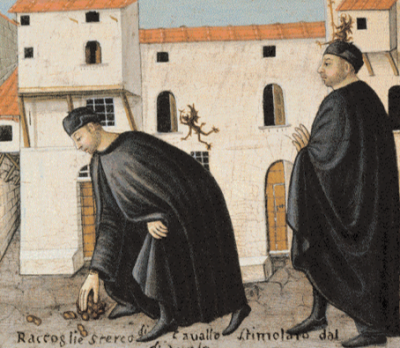
Black appealed to clerics and religious reformers because of the virtuous and moral connotations that associated the colour with humility, temperance and good religious morals [Figure 3].[7] Although Savonarola’s sabotage of colourful garments did not last long, black continued to be favoured in Florence, and the colour developed in the city, like elsewhere in Europe, from unadorned colour of moral restraint and moderation into a sumptuous, luxurious black. By the late sixteenth century, black had been established all over Europe as the colour of power and authority, not just within the courts and aristocratic circles, but also among the bourgeoisie and professionals.[8]
This chromatic shift changed not only how black was worn, but it also transformed the social cultural meanings associated with black. The traditional association of plain black with religious morals, or grief, death, loss, and mourning was complemented from the late fifteenth century onwards with a new set of cultural values which associated black not only with wealth and authority, but also with desirable ‘intrinsic’ qualities, such as trustworthiness, honesty, and loyalty.[9] A Sicilian treatise on colour praised black as early as 1430s, stating that “Even though the colour black seems sad, it is of high standing and great virtue. That is why the merchants and rich bourgeois, men as well as women, are dressed and adorned in it.”[10]
The capacity of black to convey meanings that could be at once conspicuous and simple made black, as John Harvey has noted, a particularly suitable colour for power-dressing. Even the most expensive sumptuous black garments, such as those worn by Philip the Good or Charles V in their portraits, associated the wearer at once with good civic and religious morals, as well as with wealth, luxury and power.[11]
The quality of black both as a colour of status as well as that of moderation and dignity was outlined in contemporary sources. Praising the qualities of black in his Il Cortegiano, a handbook for the ideal courtier, first published in 1528 in Venice, the courtier Baldassare Castiglione (1478–1529), for example, advocated black as the most appropriate and graceful colour at the court: “It still pleases me if it [the courtier’s dress] tends towards gravitas and temperance, rather than towards idle vanity. Therefore, I am of the opinion that a black colour has more grace in garments than any other; or if not truly black it should at least be of a dark hue.”[12]
Black was also seen increasingly as the most appropriate colour for affluent merchants and adult men and women of citizen status. Sumptuary laws issued in Florence in 1638, for example, determined that all women of citizen status who had been married over six years had to cover their colourful skirts, bodices, and sleeves with unadorned black overgarments when they appeared in public; after 12 years of marriage, they were required to dress “all in black.”[13]
This cultural gravity of black, and the changing meanings that no longer associated the colour only with grief, mourning, or strict religious morals, but also to a number of desirable civic qualities such as wealth, status and dignity, contributed in important ways to why black garments appealed widely to the European aristocrats and mercantile and political elites.
The Material Value of Black
The high cultural value associated with black was not related solely to the symbolic significance of the colour, but it was also bound up with the visual and material qualities of black. In order to appeal to the European elites, black had to be pure, deep and intense.[14]
Good, fast black was difficult to achieve. Pastoreau has noted that, until the mid-fourteenth century, dyers did not really know how to get a good black; most fabrics and clothing that they produced had a greyish, blueish, and sometimes brownish appearance.[15]
The best-known method to achieve black in the Renaissance period was to dye the fabric first in dark blue with woad, and then, after treating it with alum and tartar, to overdye the blue fabric in a red madder bath. The dark blue ground guaranteed a level of intensity for the black, and variations of the same method could be used to produce different shades of high-quality black fabrics, such as dark purple or brownish colours.[16]
This method, however, was relatively expensive, not only because of the cost of the dyestuffs, but also because preparing the vat from woad or indigo was a laborious process that required fermenting the dye solution for several days.[17] A cheaper and less labour-intensive method was to dye black using barks and roots or other vegetal dye sources that contained tannins, such as alder bark, walnuts, chestnuts and oak galls. Combined with vitriol or other iron compounds, tannins gave a beautiful, fast black. But iron had to be used with care, because adding too much iron destroyed the fabric, especially when applied on wool.[18] Another well-known method in the Renaissance period to create black was to use a recipe that relied on lye and white lead. This method coloured the fabric tawny brown and, when repeated several times, the procedure resulted in black. A test carried out at Columbia University on this method showed that, while soaking the samples twice in the dye solution for 15 minutes turned the fabrics black, this recipe was even more detrimental to the woollen fabric. The wool became completely disintegrated, if it was not immediately removed from the dye solution and placed in a fresh pot.[19]
As the demand for black intensified, sixteenth- and seventeenth-century dyers were trying to invent new ways of dying black that would overcome the problems and produce better and cheaper blacks. Experimentation at the time was quite widely practiced, as we can see in the large number of dye recipes that appeared in print. One of the most important collections of dye recipes is found in the work of Gioanventura Rosetti, who published in 1548 the first comprehensive printed book of dyeing and leather tanning, called The Plictho. His manual contained altogether 21 recipes for black, including eight recipes for a “very beautiful black,” most based on a combination of iron salts with tannins from oak galls, sumac, or alder bark.[20]
Dye recipes for black continued to appear in collections of recipes, known as Books of secrets, throughout the seventeenth century.[21] Many of these were simple and resulted easily in beautiful blacks. For example, a recipe for an “instant black,” from a Dutch dye manual available as an inexpensive printed booklet and based on boiling madder and oak galls with iron sulphate, gum arabic and iron filings, could be used to produce a beautiful uniform black relatively quickly and in a simple way.[22] Some of these recipes relied on new imported dyestuffs, such as logwood, discovered by the Spanish in Mexico in the early sixteenth century and disseminated widely across Europe in the seventeenth century. Logwood provided a new and a much less complicated way to achieve a good black than using gall nuts or woad and madder, and eventually gave a beautiful and strong black with good lightfast properties.[23]
The broad variety of methods and dye sources for achieving black meant that by the early seventeenth century, the spectrum of blacks was wide, ranging from light and dull to brilliant tones.[24] Chiara Buss’s analysis of a Milanese textile sample book from 1628, which recorded all foreign silks that were currently on sale in the city, shows that from the 32 black samples included in the book, only three represented the richest, colour-saturated black. Most of the blacks were less intense reddish or greenish blacks, or dull blacks dyed on waste silk. The rest were low-quality blacks that tended heavily towards brown. These were not considered even really black, because brown colour was regarded as a black that had faded as a result of a poorly dyed fabric.[25]
The variety of blacks, and the many techniques and dye sources that were available to achieve different shades of the colour, made black textiles increasingly affordable for a wider range of consumers. The price of black fabrics on the market was surprisingly low, compared to other colour fabrics. For example, Elizabeth Currie’s work on a fifteenth-century Florentine codex that listed prices of different colour fabrics shows that black, priced at 15 soldi per pound, was cheaper than most other colours, including green-brown (verde-bruno), deep violet (alessandrino), purple (pavonazzo), and red dyed with crimson kermes. The only colours that were less costly than black were tawny brown (tané), light blue (inciannomati), faded colours (sbiaditi), and greys (bigi).[26] Evidence from France in 1580s shows that fabrics selected for affordable black dyes were also sometimes very thin, “so that the dyeing is inexpensive.”[27] As beautiful black was obtained with a costly overdye technology—dyeing first with woad and then with a red dye—selecting a thin fabric could make black much more affordable since less dyestuffs were needed per ell.
In addition to black textiles that were on offer at a fairly affordable price on the market, relatively beautiful blacks could also be produced at home. Simple and less-labour intensive methods for achieving black—some of which were forbidden from professionals by the guilds—were circulated in cheap printed media.[28] These made it easy and cost-effective for men and women to carry out dye processes within the domestic setting, along with other textile-related recipes, such as stain removal. One of the common recipes for home-dyed “lustrous” black, directed at “women so that when they have spun yarn they know how to dye it in many colours,” for example, gave instructions of how to dye black at home, using oak gall, vitriol, and a small amount of gum arabic [Figure 4]. This recipe, circulated in several printed works (including large compendiums such as the Plictho, and in Dutch and French translations of the Dificio de ricette, the first printed Book of secrets published in Italy in 1525), was available also for ordinary people in cheap printed media, with similar wording and always with identical ingredients.[29] The recipe for black advised one to
take a little broken oak gall and let it boil in a little pipkin with water. And when it has boiled a little, take away all the oak gall and put in some Roman vitriol [iron II sulphate], the same amount as the oak gall and a little gum arabic, boil it and put in your yarn in it and let it boil a little and you would have it good, black and lustrous.[30]
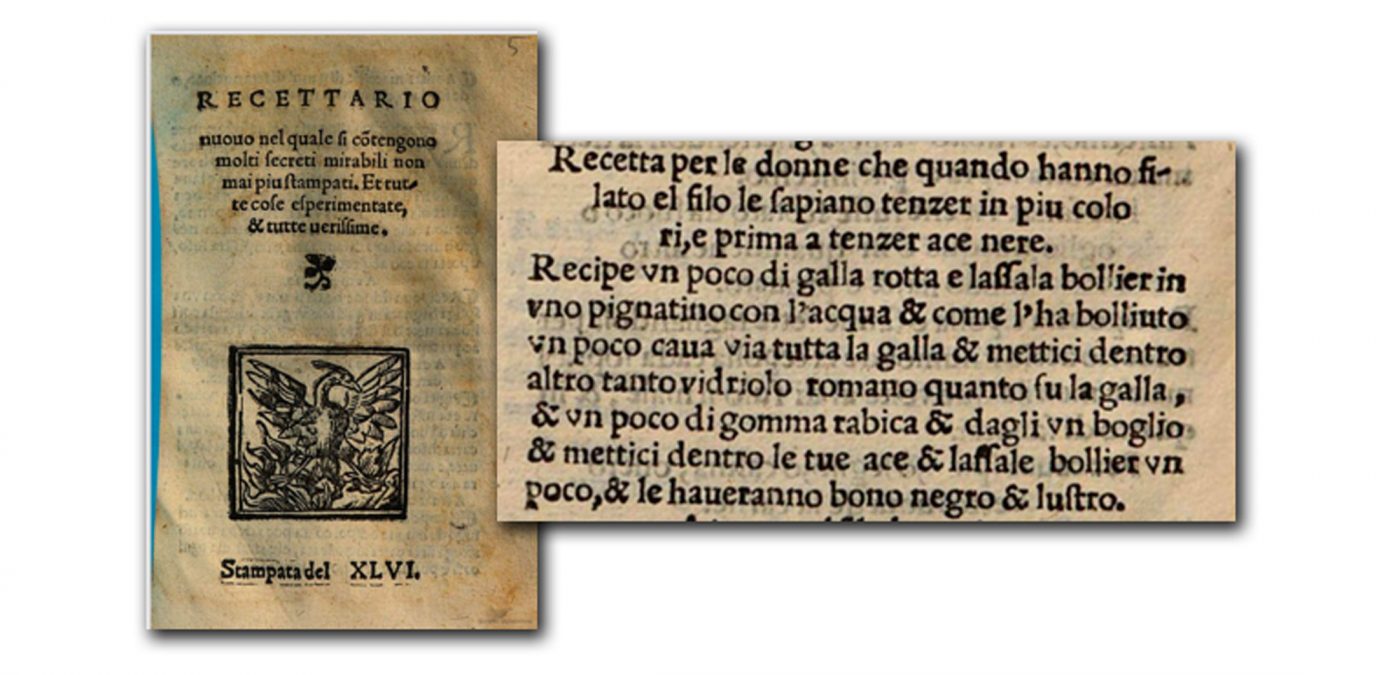
A dye experiment testing this home-dye recipe on wool, silk and linen demonstrated that the recipe could produce relatively good results. Although following the recipe alone did not result in a saturated black, pre-mordanting the textile with iron gave a relatively good and uniform black, especially on wool, as seen in the leftmost image of Figure 5. Compared with the tone of more expensive blacks overdyed with madder, such as the French recipe of 1649 for “Black of Flanders,” the tone appears only slightly less bright.[31]
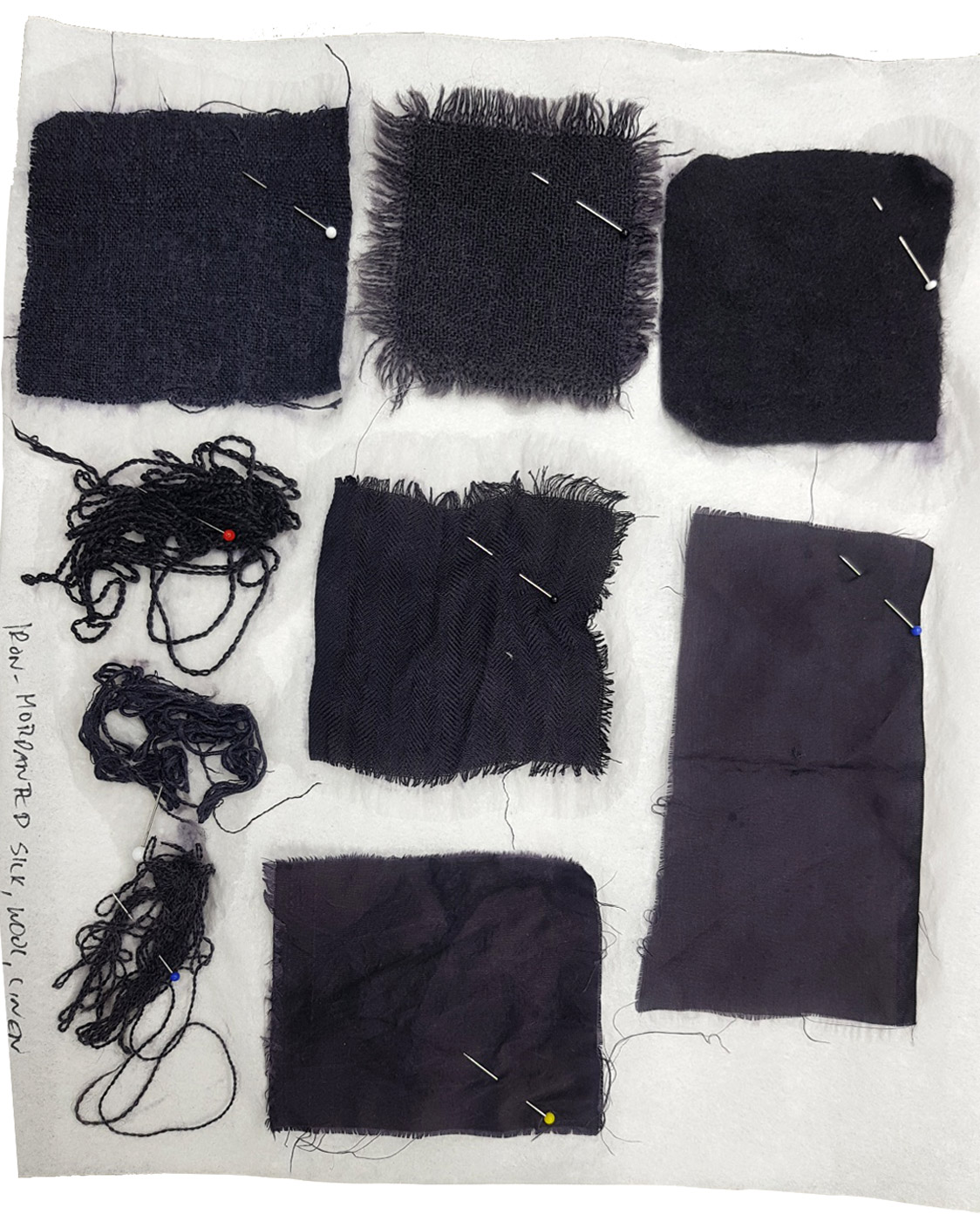
Even cheaper and simpler methods to produce good blacks that would not last long but would look briefly impressive could be tried at home. Some even used simple methods such as applying lampblack or charcoal on the surface of the fabric to achieve a deep black, a practice that became increasingly widespread in the sixteenth century.[32] Although black produced in this way was obviously not durable, the simple and inexpensive procedure produced a beautiful, uniform colour that could be easily brushed up by repeating the procedure. Pre-boiling the fabric in a hot mixture of tannins before treating the cold surface gave even a better black.[33]
These varied and cheaper methods to produce black, based on a range of recipes and dye sources, made it sometimes not only difficult to distinguish a cheap black from ‘true’ black, but also ensured that black as a fashionable colour became socially widespread.
The Social Meaning of Black
According to Renaissance ideology, black garments, such as those painted in fifteenth and sixteenth portraits, were ideally reserved only for those who held power and authority in society. Sumptuary laws issued all over Europe in the medieval and early modern period tried to restrict the use of expensive textiles and garments only within the nobility and high-ranking wealthy elites.[34]
These regulations also included, for the first time in the sixteenth century, rules about wearing black. For example, the laws concerning the use of black in Siena, issued first in 1588, made it absolutely forbidden for men and women to wear black, as well as dark pavonazzo-purple, considered a kind of ‘sub-black,’ unless they were connected to the ruling classes through their birth or marriage.[35] The laws were repeated in the Sienese Statutes in 1599. The later regulations focused especially on black male overgarments worn at the lower social levels. Men outside the governing class were forbidden to wear black overgarments, such as cassocks and jackets, allowing black colour only on collars, hat linings and trims.[36]
This ideal chromatic difference of dress was often visualised in contemporary genre paintings, where lower class people were presented in colourful clothing. In contrast to the intense black gowns worn by powerful men and women in their pictures, servants, street vendors and craftsmen were usually painted by artists, such as Vincenzo Campi or Pieter Brueghel the Elder, working or dancing in bright or faded green, yellow, pink and blue gowns [Figures 6 and 7]. Beggars, elderly women, and those on the margins of society were dressed in faded grey or brown, colours that were considered “by definition poor and located at the lowest levels of the hierarchical scale” [Figure 8].[37]
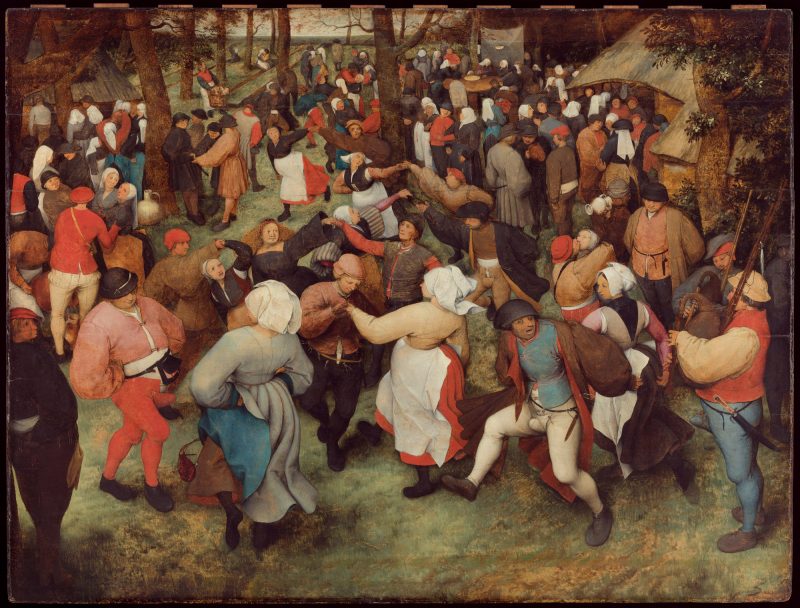
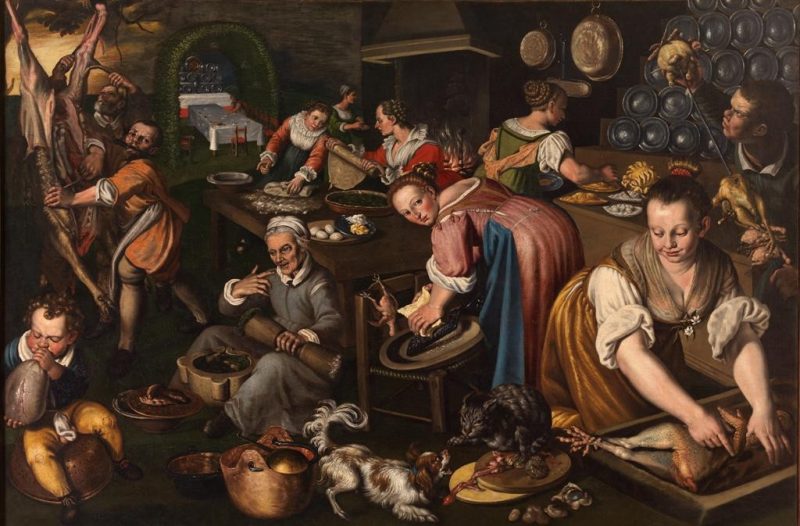

Yet, this may not have necessarily corresponded with the way Europeans dressed in everyday life. Some literary sources suggest that, despite regulation of dress, it was increasingly difficult in the Renaissance period to identify social classes through dress. In his La Civil conversazione, the Italian writer Stefano Guazzo, for example, complained,
You see that peasants dare to compete in their clothing with artisans, and artisans with merchants, and merchants with noblemen, so much so that once a grocer has taken up the habit of carrying arms and wearing the clothing of a noble, you cannot tell who he is until you see him in his shop selling his wares.[38]
This was also the case with black. Documentary sources show that, as technologies of dyeing black became cheaper and more sophisticated, black became widely disseminated across social classes in the Renaissance period. Data from Venice, Florence and Siena show that, by the mid-sixteenth century, black was by far the most common colour of clothing also at the level of ordinary artisans and shopkeepers. In post-mortem inventories from these cities drawn up between 1550 and 1650, 40.2% of all artisans’ clothes that defined the colour are described as black. The most common of these items, accounting for 26% of all black clothing, were black woollen overgowns (vesta, zimarra), worn both by men and women. This was followed by cloaks, cassocks, jackets, doublets and hose, as well as linings and felted hats. While most cassocks and jackets belonged to men, a remarkable variety of black garments belonged also to women, ranging from elaborate gowns, petticoats, and cloaks to small caps and detachable sleeves. The majority of black garmentswere made of wool (36.8%), ranging from ordinary woollens described simply as panno to expensive high-quality wool fabrics such as say and rash. Silks (24.8%) and mixed fabrics (14.1%) were also common in black, including waste silk and light- and medium-weight silks, such as taffeta, ormesino, tabby or satin. It is notable that, in addition to more affordable silks, ordinary Italians’ black clothing also included items that were made of heavier damasks and grosgrains, and even of silk velvets. The latter, despite its high price, accounted for 3.56% of all black clothing. In addition to real velvet, the sample also includes black garments that were made from mixed woollen and linen fabrics that imitated the effect of velvet, such as mockado.[39]
Similarly, the ubiquity of black in dress among the ‘middling’ ranks has been identified in Bruges, where black appears to be by far the favoured colour in the later part of the sixteenth century, accounting for between 45% and 54% of all clothes.[40]
What is significant about the widespread use of black is not only the fact that it was worn by so many, but that the values and beliefs associated with black clothing were socially so widely shared in society. The potential of black garments to convey status and distinction across the lower social classes becomes evident in some visual sources, such as in the depiction of shoemakers from Nuremberg from about 1600 [Figure 9]. Here, the guild officers and masters are presented in self-confident poses, wearing fine black liveries under their leather jerkins, together with white linen shirts and starched ruffs, and fine stockings with flat black shoes. The colour black gave the wearer a degree of dignity and authority.
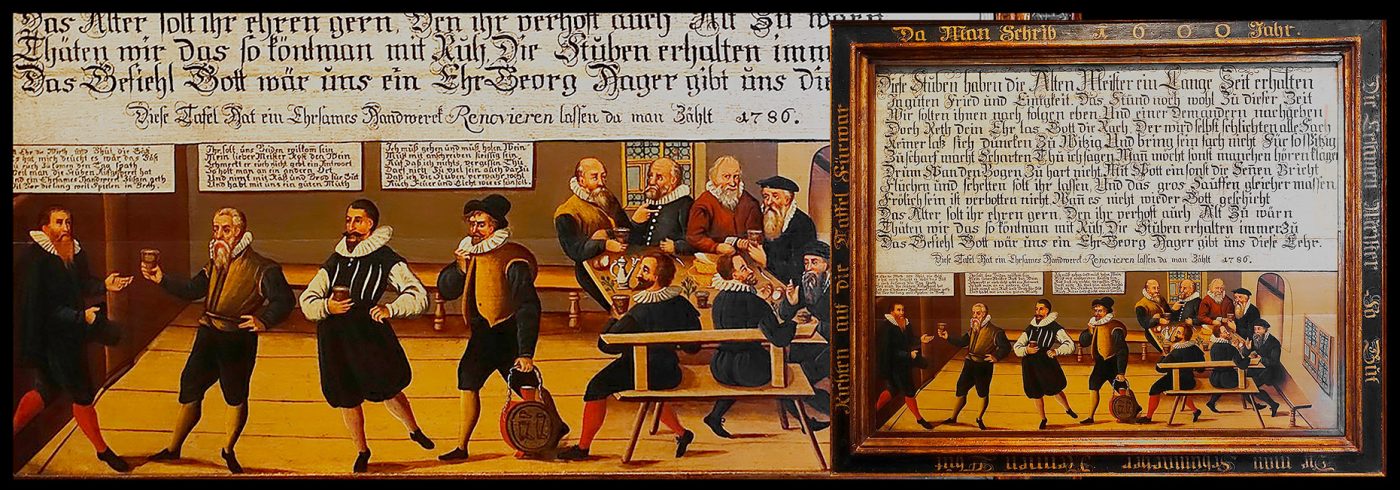
All this evidence suggests, then, that although black clothing was forcefully promoted as the symbolic colour of status and distinction by the European elites in both portraiture and real life, black was not the colour of princes, courtiers or mercantile elites only. Even though there were many differences in dress, comportment or qualities of black between different social classes, all groups and individuals who wore black, including ordinary urban artisans and shopkeepers, could benefit from the dignity, authority and power associated with the colour within their own social circles.[41]
This ‘democratizing’ quality of black which united rather than divided social classes, made possible by the availability of new dyestuffs and more varied methods of dyeing, added another significant layer to the diverse social, culture and material meanings of black, and gave the colour a truly unique status among the chromatic politics of textiles in Renaissance Europe.[42] All this shows that black in the Renaissance period was a culturally and materially rich colour, whose meanings were complex and moved in multiple and sometimes conflicting directions.
NOTE:
This article was written with the support of the Refashioning the Renaissance project, which has received funding from the European Research Council under the European Union’s Horizon 2020 research and innovation program. Grant agreement No. 726195.
Bibliography
Archival records:
Archivio di stato (ASS), Siena, Balia 830 (1599).
Archivio di stato, Firenze (ASF), Libri di commerico, 3006 (previously recorded as 787).
Refashioning the Renaissance Database. Available online in 2022 at https://refashioningrenaissance.eu/database/.
Primary sources :
Nicolai, Gerbrandus. Een Cleyn Verff-Boecken Inhoudende Seer Constighe Saeyet Verwen, Nut En Profytelijck Voor Breyders En Oock Voor Andere Persoonen Die Haer Dit Werck Mede Willen Bemoeyen. 2nd edition. Leeuwarden: Gysbert Sybes, 1638.
Fasciculo de molte cose meritevole de ogni laude si i arte di medicina et per riparatione di molte infirmita: como in magisterio di molte gentilezze, & per dare spasso alle mente de faticati populi da molti homini, dignissimi per ricreatione de danni. Composto & ridotto in questa operetta movissimamente ventua in luce meritamente. Intitulata Specchio di virtu (n.p.: per Paulo Danza, n.d.).
Guazzo, Stefano. La Civil Conversazione, ed. Anadeo Quondam, vol I, (Ferrara, Franco Cosimo Panini, 1993).
Opera nova chiamata Secreti secretorum: in laquale poterai conseguire molti piaceri et utilitade: con molte cose ridiculose stampata novamente. ([n.p., n.p., n.d.]).
Opera nova de Ricette et Secreti che insegna apparecchiar una Mensa a uno convito… ([n.p., n.p, n.d.]).
Opera nova excellentissima: la quale i senga di far vari secreti: et gentileze esperimentate sopra diversi effetti come i ditta opera si contiene. Intitulata: Probatum est. Del. Mirabolano M.D.xxvuij ([N.P.: n.p., 1529]).
Rosetti, Gioanventura. The Plictho: Instructions in the Art of the Dyers Which Teaches the Dyeing of Woolen Cloths, Linens, Cottons, and Silk by the Great Art as Well as by the Common. Facsimile and Translation of the First Edition of 1548. Edited by Sidney M. Edelstein and Hector C. Borghetty. Cambridge and London: M.I.T. Press, 1969.
Recettario nuouo nel quale si co[n]tengono molti secreti mirabili non mai piu stampato. Et tutte cose esperimentate, & tutte uerisime ([n.p.: n.p.,] (1546).
Recettario Nuovo Copiosissimo (n.p.: n.p., 1550).
Recettario nuouo nel quale si co[n]tengono molti secreti mirabili non mai piu stampato piu stampato. Et tutte cose esperimentate, & tutte uerisime ([n.p.: n.p.,] 1546).
Riforma, e Prammatica sopra l’uso delle perle, gioie, vestire, et altro per la Città & Contado di Firenze (Fiorenza: Massi e Landi 1638), A2.
Secondary Sources:
Black, Exhibition catalogue for “Masters of Black in Fashion & Costume,” (Antwerp: MoMu, 2010).
Braekman, Wily L. Dat batement van recepten. Een secreetboek uit de zestiende eeuw [Reprint of Een nieuwe tractaet / ghenaemt dat Batement van recepten / inhoudende drye deelen van Recepten. Nv van nieuws gecorrigeert ende verbetert, Antwerpen, Hans de Laet, 1549] (Brussels: Omirel UFSAL, 1990).
Buss, Chiara. “A Very Fine Black Color,” in Silk, Gold, Crimson: Secrets and Technology at the Visconti and Sforza Courts, ed. Chiara Buss and Annalisa Zanni (Milan: Silvana Editoriale, 2009).
Buss, Chiara. Seta: Dizionario delle mezzetine 1628–1939: Da avinato a zizzolino (Milan: Silvana editoriale, 2013).
Buss, Chiara. “Half-Tints in Italy in 1628: An Usual Book of Samples from the Milan State Archives,” in Inventories of Textiles, Textiles in Inventories: Studies on Late Medieval and Early Modern Material Culture, ed. Thomas Ertl and Barbara Karl (Vienna: Vienna University Press 2017), 165–200.
Calvi, Giulia. “Abito, genere, cittadinanza nella Toscana moderna (Secoli XVI–XVII),” Quaderni Storici, 110 (2002), 477–503.
Cerri, Monica. “Sarti Toscani nel seicento: Attività e clientele,” in Le trame della moda, ed. Anna G. Cavagna and G. Butazzi, (Rome: Bulzoni, 1995), 421–433.
Currie, Elizabeth. Fashion and Masculinity in Renaissance Florence (London: Bloomsbury Academic, 2016).
Eamon, William. Science and the Secrets of Nature: Books of Secrets in the Medieval and Early Modern Culture (Princeton: Princeton University Press, 1996).
Edmonds, John. The History of Woad and the Medieval Woad Vat, Historic Dyes Series, No. 1 (2006).
Frick, Carole. Dressing Renaissance Florence: Families, Fortunes and Fine Clothing (Baltimore, London: Johns Hopkins University Press, 2002).
Hartl, Anna, Art Néss Proaño Gaibor, Maarten R. van Bommel, and Regina Hofmann-de Keijzer. “Searching for blue: Experiments with woad fermentation vats and an explanation of the colours through dye analysis,” Journal of Archaeological Science: Reports, Vol 2 (2015), 9–39.
Harvey, John. Men in Black (Chicago: University of Chicago Press, 1995).
Hofenk de Graaff, Judith H. The Colourful Past: Origins, Chemistry and Identification of Natural Dyestuffs. London: Archetype Publ, 2004.
Hohti, Paula. “Dress, Dissemination and Innovation: Artisan Fashions in Sixteenth- and Early Seventeenth-Century Italy,” in Fashioning the Early Modern: Dress, Textiles and Innovation in Europe, 1500–1800, ed. Evelyn Welch (Oxford: Pasold Research Fund, Oxford University Press, 2017), 143–168.
Kirby, Jo, Maartin Van Bommel, and André Verhecken. Natural Colorants for Dyeing and Lake Pigments: Practical Recipes and their Historical Sources (London: Archetype Books, 2014).
Kovesi-Killerby, Catherine. Sumptuary Law in Italy 1200–1500 (Oxford: Oxford University Press, 2002).
Deblock, Geneviève. Le bâtiment des recettes: présentation et annotation de l’édition Jean Ruelle, 1560 (Rennes: Presses universitaires de Rennes, 2015).
Molà, Luca. The Silk Industry of Renaissance Venice (Baltimore, London: Johns Hopkins University Press, 2000).
Munro, John H. “The Anti-Red Shift to the ‘Dark Side’: Colour Changes in Flemish Luxury Woollens, 1300 – 1550.” In Medieval Clothing and Textiles, edited by Robin Netherton and Gale R Owen-Crocker, Vol. 3. Woodbridge: Boydell, 2007.
Orsi Landini, Roberta. La Moda a Firenze 1540–1580: Lo stile di Eleonora di Toledo e la sua influenza (Florence: Edizioni Polistampa, 2007).
Ortega Saez, Natalia. “Black Dyed Wool in North Western Europe, 1680–1850: The Relationship between Historical Recipes and the Current State of Preservation” (unpublished Ph.D. thesis, University of Antwerp, 2018).
Owen Hughes, Diane. “Sumptuary Law and Social Relations in Renaissance Italy,” in Disputes and Settlements: Law and Human Relations in the West, ed. John Bossy (Cambridge: Cambridge University Press, 1983), 69–99.
Owen Hughes, Diane. “Distinguishing Signs: Ear-rings, Jews and Franciscan Rhetoric in the Italian Renaissance City,” in Past and Present, Vol. 112 (1986), 3–60.
Pastoreau, Michel. Black: The History of a Colour (New Jersey, Oxfordshire: Princeton University Press, 2008).
Pitman, Sophie. “Black Color for Dyeing, and the Place of Textiles in BnF Ms. Fr. 640,” in Secrets of Craft and Nature in Renaissance France: A Digital Critical Edition and English Translation of BnF Ms. Fr. 640, https://edition640.makingandknowing.org, ed. The Making and Knowing Project, Pamela H. Smith, Naomi Rosenkranz, et. al. (2020), https://edition640.makingandknowing.org/#/essays/ann_036_sp_16.
Riello, Giorgio, and Ulinka Rublak, eds. The Right to Dress: Sumptuary Laws in a Global Perspective, c. 1200–1800 (Cambridge: Cambridge University Press, 2019).
Rublak, Ulinka “Renaissance Dress, Cultures of Making, and the Period Eye,” Journal of Decorative Arts, Design History, and Material Culture 23, No. 1 (Spring-Summer 2016), 6–34.
Secrets of Craft and Nature in Renaissance France: A Digital Critical Edition and English Translation of BnF Ms. Fr. 640, https://edition640.makingandknowing.org, ed. The Making and Knowing Project, Pamela H. Smith, Naomi Rosenkranz, et. al. (2020), https://edition640.makingandknowing.org/#/folios
Strathern, Paula. Death in Florence: The Medici, Savonarola and the Battle for the Soul of the Renaissance City (London: Jonathan Cape, 2011).
Sturtewagen, Isis. “All together Respectably Dressed: Fashion and Clothing in Bruges in the Fifteenth and Sixteenth Centuries” (unpublished PhD dissertation, University of Antwerp, 2016).
Williams, Susan Kay. The Story of Colour in Textiles (London: A & C Black Publishers Ltd, 2013).
Pastoreau, Black, 102.
Pastoreau, Black, 102.
Pastoreau, Black, 102.
Pastoreau, Black, 102.
Pastoreau, Black, 102.
Pastoreau, Black, 102.
[32] This practice seems to have appealed not only for home dyers, but also for professional dyers who were eager to cut the costs of producing black and sell their products off with a more expensive price. See Pastoreau, Black, 92. There were also other new controversial methods of dyeing silk, such as the method known ‘goro a crescente’, initially applied on haberdashery and tabbies, which produced black in a cheaper way. See Molà, Silk Industry, 133-138.
[32] This practice seems to have appealed not only for home dyers, but also for professional dyers who were eager to cut the costs of producing black and sell their products off with a more expensive price. See Pastoreau, Black, 92. There were also other new controversial methods of dyeing silk, such as the method known ‘goro a crescente’, initially applied on haberdashery and tabbies, which produced black in a cheaper way. See Molà, Silk Industry, 133-138.
[32] This practice seems to have appealed not only for home dyers, but also for professional dyers who were eager to cut the costs of producing black and sell their products off with a more expensive price. See Pastoreau, Black, 92. There were also other new controversial methods of dyeing silk, such as the method known ‘goro a crescente’, initially applied on haberdashery and tabbies, which produced black in a cheaper way. See Molà, Silk Industry, 133-138.